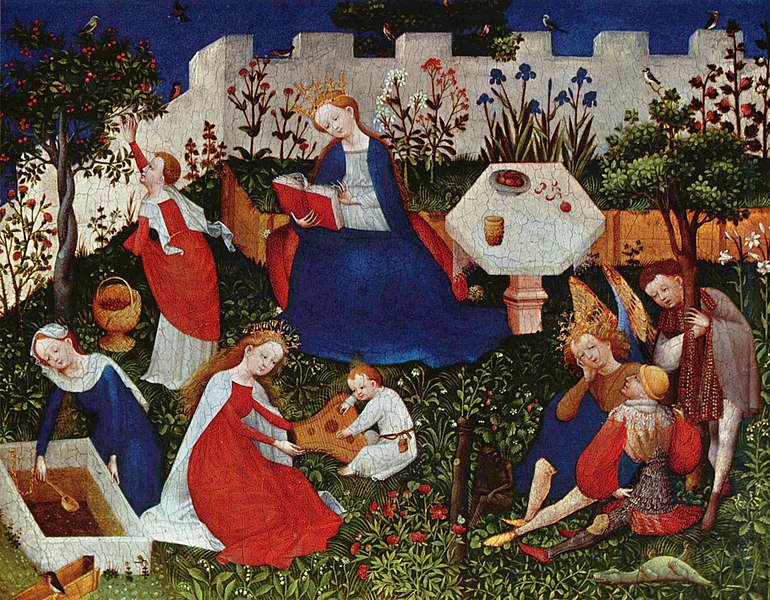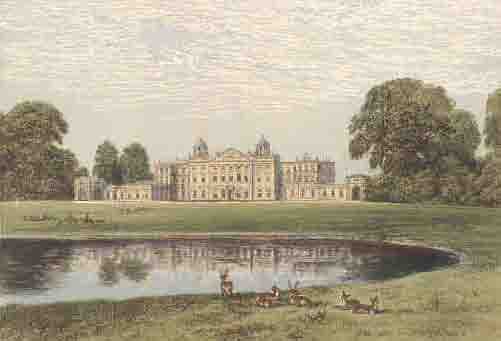
German Garden, 1410.
Gardens and domestic outdoor spaces have always been a feature of our lives. Most Tudor homes had a garden of some sort, or else some land attached, even in the middle of a city like London. Their use was heavily dependent upon class, either to supplement the table and produce essential medicinal herbs or as arenas to display luxury and status. Native fruit and vegetables in season could make a huge difference to a lower-class family's diet and the cultivation and use of herbs, a remnant of the medieval monastic tradition, came from a rich oral tradition of home cures for every eventuality. Many were functional living spaces too, used for all manner of domestic work, including washing and drying, although fields outside the city walls were also emplyed in this way. Palace gardens were resplendent with statues and ornaments; the garden at Whitehall contained gilded heraldic beasts whilst at Kenilworth, the gardens became the famous stage for Elizabeth I's visit, remodelled with fountains, lake and island. There was little concept of garden design outside upperclass circles, with outdoor spaces being maximised for their productive abilites, as well as the exercise of man and beast. However, small knot gardens, full of scented herbs and plants were made along intricate lines and not beyond the reach of the middle classes. Their symmetrical designs, redolent of early Persian gardens, are the most archetypal of Tudor garden survivals..
A knot garden, recreated at the Garden Museum, Lambeth.
Seventeenth century gentlemen, returning from the grand European tour, brought back an appreciation of dramatic natural geographic features. "Sublime" mountains and Alpine-style lakes became all the rage. Mock Graeco-Roman ruins were imported into English landscapes, crumbling away among parks like that at Windsor. Completely new follies were built and artifically aged. Formal gardens betrayed Dutch and Italian influences too, balancing areas of symmetry and order with areas of wilderness to express the sublime power of the natural world. Specific areas were tamed into avenues, topiary creations, terraces and waterworks, whilst others, often distant were left to grow wild as described in Austen's Mansfield Park. Contained within the garden's confines, her jumbled-up pairs of lovers manage to contain their lusts but the temptation of entering the wildeness through the locked gate proves their undoing. Blenheim, Hampton Court and Versailles all demonstrate this balance between the careful, man-tamed environment and the wilderness beyond. It was to give an illusion of connection between the two, whilst allowing a degree of protection, that the sunken ditch known as the ha-ha came into use as a boundary. The garden became a playground, spurting jets of water among statues and using straight lines to create outdoor rooms. Poems by Andrew Marvell contrast the wild world inhabited by the mower with the formal yet playful environment of the great house. The abundance of flowers, fruit and vegetables he mentions are typical of the new methods of gardening, where exotic plants from the new world were grafted and unseasonably forced in large greenhouses and new colours blended and created. For the wealthy, it was an era of orangeries and tulips.

Badminton Morris House, Gloucestershire, with its deliberately "undesigned" park design.
The natural look became increasingly prevalent in the Eighteenth and early Nineteenth centuries, with vast parks being swept clean of unsightly features like villages; wavy lines, trees and grass growing freely with grazing sheep echoed an aristcratic preoccupation of the European bucolic ideal, such as epitomised in the novels of Anne Radcliffe, paintings of Claude Lorrain and romantics like Samuel Palmer and Caspar David Friedrich. Capability Brown worked on over 170 gardens in England during this time, advocating a "gardenless" form of gardening; his works survive at Coombe Park, Warwick Castle and Bowood House among others. Again, class was significant. Outdoor spaces became increasingly public and the vast parks of cities like London, Paris and Vienna became the locations for Sunday family promenades as well as political rallies.The old eighteenth century pleasure gardens, with something of an unsavoury reputation, as in Thackeray's Vanity Fair gave way to the more genteel tea gardens depicted by the Post-Impressionsts. Huge market gardens produced fresh fruit and flowers which the spread of railways allowed to grace city dining tables of the rich. With more produce becoming available, gardens became increasingly about relaxation and the achievement of a casual, meadow-style look. Native plants were sown with apparent abandon, to create the impression of self-seeding in what was actually careful planning, by cottage-garden designers such as Gertrude Jekyll. Her romantic, pretty planting with its subtle colours and blowsy borders was developed by other early twentieth century enthusiasts like Vita Sackville-West. The romance and escape of gardens was popularised by the 1909 best selling "Elizabeth and her German Garden" and its sequels, by Elizabeth von Arnim.

Gertrude Jekyll border at Manor House, Upton Grey, Hampshire
The Twentieth century saw garden design becoming increasingly architectural. Unusual features and play between the natural and man-made are popular again, as any visit to Hampton Court Flower show will demonstrate. Large panels of synthetic materials in bright colours sit along side rustic-style modern follies, whilst a wealth of innovative planting allows for exciting contrast and variety in texture, scent and colour. Features like decking, patios and planting boxes allow even small gardens to maxmise their space, providing an extra room in over-crowded urban areas. The popularity of conservatories has seen them change from the overwhelmingly green waxy-leaved hot houses of the Victorian upper classes, with their heavy furniture, to lighter, open spaces that combine the best of indoor and out. Cheap garden fittings, furniture, plants and barbeques encourage us to get outside as much as possible, whilst TV makeover and DIY programmes give cheap inspiration regarding the transformation of our backyards. In a complete reversal from their use by our grandparents, to house Anderson shelters and dig for victory, gardens have become our arenas for experimentation and self-expression. In the modern garden, anything goes.

Electric car on display at the 2009 Hampton Court Flower Show

No comments:
Post a Comment